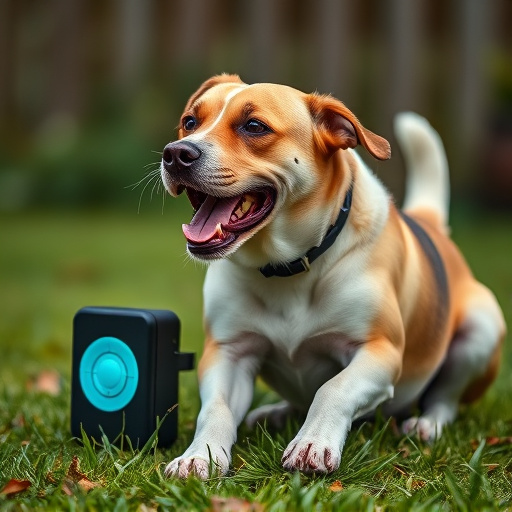Dogs' behaviors stem from instincts and environment, making behavior modification crucial for training. Ultrasonic repelents, using inaudible sound waves, disrupt unwanted actions like barking or aggression. Handheld devices offer portability, convenience, and dynamic solutions for specific challenges, while wall-mounted options provide consistent, targeted protection for larger areas. The choice depends on needs for portability vs. long-term, hands-off training; handhelds are ideal for quick redirects, but wall-mounted units ensure continuous positive behavior change without constant intervention. Safety and patience are key during training with these human-safe tools.
“Unleash a new way to train your furry friends with Ultrasonic Frequency Dog Behavior Modification Tools. This innovative technology offers a non-violent approach to addressing unwanted behaviors, from barking to jumping on furniture. In this comprehensive guide, we explore the power of ultrasonic technology and its various forms. From handheld devices offering portability for on-the-go training to wall-mounted deterrents strategically placed around your home, discover the advantages and considerations of each. Learn how these tools can enhance traditional training methods while prioritizing safety.”
- Understanding Dog Behavior and Ultrasonic Technology
- Handheld Ultrasonic Repellents: Portability and Convenience
- Wall-Mounted Devices: Strategically Positioned Deterrents
- Advantages and Considerations of Each Approach
- Training and Safety: Effective Use of Ultrasonic Tools
Understanding Dog Behavior and Ultrasonic Technology
Dogs, like all animals, have complex behaviors driven by instincts and environment. Understanding these nuances is crucial when implementing behavior modification tools. Ultrasonic technology offers an innovative approach to addressing unwanted behaviors like excessive barking or aggression. These devices emit high-frequency sound waves that are inaudible to humans but can capture a dog’s attention and alter their response.
Choosing between handheld and wall-mounted ultrasonic repelents depends on specific needs. Handheld devices provide convenience, allowing you to target problematic areas on the go. Wall-mounted options, however, offer continuous protection for larger spaces, making them ideal for homes with multiple floors or outdoor enclosures. Each type leverages the same core technology, but their deployment strategies differ based on user preference and situation.
Handheld Ultrasonic Repellents: Portability and Convenience
Handheld ultrasonic repelants offer a level of portability and convenience that their wall-mounted counterparts often lack. Their compact size allows for easy transport, making them ideal for use in various settings—from homes to outdoor spaces, cars to pet kennels. Unlike fixed devices, handheld options can be quickly moved to different areas as needed, offering dynamic solutions for specific behavioral challenges.
Compared to wall-mounted ultrasonic repelants, handheld models provide greater flexibility and accessibility. They are perfect for temporary situations or for addressing issues in hard-to-reach spots. Moreover, their battery-powered designs ensure continuous use without the need for constant plugging into an outlet, further enhancing their convenience during travel or outdoor activities involving pets.
Wall-Mounted Devices: Strategically Positioned Deterrents
Wall-mounted ultrasonic devices offer a strategic advantage over handheld repellents, placing deterrents in fixed positions throughout your home or yard. This method ensures consistent protection and targeted intervention when dealing with unwanted dog behaviors like jumping on furniture or barking excessively. By mounting these devices in key areas, you can train your dog to associate certain spaces with specific noises, reinforcing positive behavior changes.
Unlike handheld repellents that require active operation, wall-mounted devices provide a passive yet effective solution. They are ideal for addressing persistent issues as they offer continuous reinforcement, allowing dogs to learn and adjust their behaviors naturally. This hands-off approach is particularly beneficial for busy pet owners who seek reliable, long-term solutions for modifying their dog’s behavior without constant intervention.
Advantages and Considerations of Each Approach
The choice between a handheld and wall-mounted ultrasonic repellent for dog behavior modification offers distinct advantages based on specific needs. Handheld devices provide convenience, allowing for easy movement around your space while training. They are ideal for apartment dwellers or those who need to redirect their dog’s attention quickly during walks. However, these portables might require more consistent use due to their temporary nature, as dogs can quickly become accustomed to the sound if it doesn’t persist consistently across different environments.
Wall-mounted units, on the other hand, offer a more permanent solution and are less obtrusive, integrating seamlessly into your home decor. They emit continuous ultrasonic signals, making them effective for long-term behavior modification. These devices are particularly suitable for homes with multiple floors or larger areas where consistent coverage is needed. Yet, they may not be as easily portable, requiring strategic placement to ensure optimal effectiveness while training.
Training and Safety: Effective Use of Ultrasonic Tools
Training and Safety: Effective Use of Ultrasonic Tools
When using ultrasonic frequency devices for dog behavior modification, understanding both the technology and proper training techniques is paramount. These tools emit high-frequency sound waves that are inaudible to humans but can deter dogs from unwanted behaviors. The effectiveness varies based on the device type; handheld ultrasonic repellents allow for precise targeting while wall-mounted units cover larger spaces. Training begins with acclimating your dog to the device’s noise, positive reinforcement for desired behavior, and gradual exposure to triggering situations. Safety is crucial; ensure the device operates within recommended frequency ranges to avoid potential harm to dogs’ hearing.
Always monitor your dog during training sessions and consult a professional trainer or veterinarian if needed. Consistent use and patience are key to success. Handheld devices offer flexibility for in-the-moment adjustments, while wall-mounted units provide continuous reinforcement in specific areas. Regardless of the type chosen, proper usage and safety protocols ensure these tools serve as effective, human-safe solutions for modifying canine behavior.
In conclusion, both handheld and wall-mounted ultrasonic repellents offer effective solutions for modifying dog behavior. Handheld devices provide portability and convenience for on-the-go training sessions, while wall-mounted units allow strategic placement to deter unwanted actions in specific areas. Understanding the advantages and considerations of each approach is key to selecting the ideal tool. When used safely and consistently, these ultrasonic technologies can significantly enhance your training regimen, promoting positive dog behavior in various environments.
